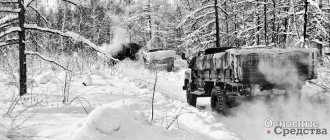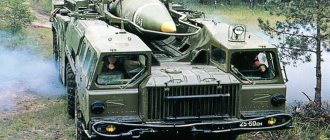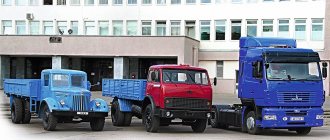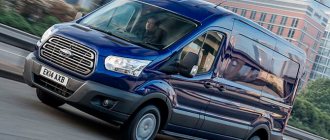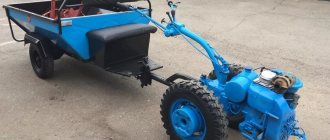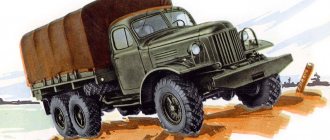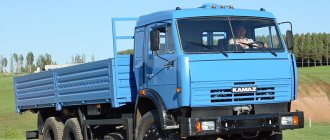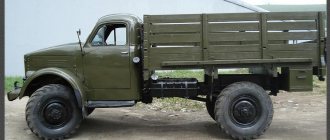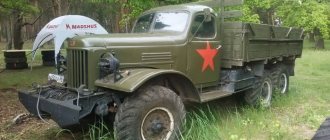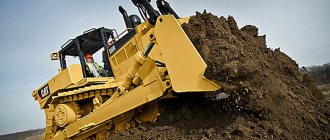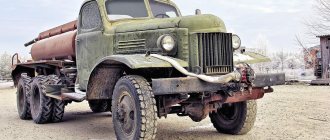The American truck Studebaker US 6 was loved and respected in the USSR. During the Great Patriotic War, it was a loyal ally of front-line drivers, and designers used it as a base when developing Soviet all-wheel drive trucks. This success can be easily explained: meticulous Americans with German roots took on the creation of the car, who carefully worked out every detail.
History of the truck
The creators of the legendary truck were representatives of the Stutenbäcker family. Oddly enough, but the machines for the war with Germany were created by the Germans. In 1736, the Stutenbackers settled in America, changed their surname slightly, and founded the company in 1852. It all started with passenger cars; there were some not entirely successful experiments with electric cars. Despite this, production flourished: children replaced their fathers and worked hard on the brainchild of their ancestors.
In 1936, Studebaker began creating trucks. When hostilities began in Europe, the company had to join the production of military vehicles. And among other units, the Studebaker United States 6 (government six-wheeled vehicle), or US6 for short, was created. Until 1945, the company intensively produced these trucks, including in various modifications, and in 1943 the REO Motor Car company joined it. After the end of the war, Studebaker returned to producing passenger cars.
Studebaker United States 6
Technically, the Studebaker US6 was a typical American car, with a standard design and classic layout. Despite this, almost nothing has been heard about these models in the United States and Western European countries. The American army was also almost never equipped with them: the fact is that US6 engines did not meet the standards accepted at that time. Therefore, it was decided to send most of the cars to other countries under the Lend-Lease program.
Legendary Studebaker: unknown military equipment of the famous manufacturer
This is the fourth and final part of our “saga” about Studebaker. In the first, we talked about the appearance of US6 trucks and their fate in the US Army, in the second, we studied the intricacies of supplying vehicles under Lend-Lease to the USSR, and in the third, we were convinced that without Studebaker, there could not have been the famous Katyushas in the Red Army.
Military firstborns against their will
From its founding until the outbreak of World War II, Studebaker did not even try to develop and produce special army vehicles, but was content with limited supplies of its serial products to the American armed forces. However, military vehicles of this brand appeared as if by themselves.
For example, the first purely civilian self-propelled cargo carts of the Studebaker brand were adopted by the US Navy for transporting goods inside the warehouses of large naval bases. These were electric delivery trucks and vans that were popular in those days and became the world's first military electric vehicles, the creation of which had a hand in the inventor Thomas Edison. The age of electric cars and horse-drawn carriages turned out to be short-lived, and in 1913 the company completely switched to cars with internal combustion engines.
| Low-speed electric Studebaker van for the US Navy. 1911 | In the photo: A machine-gun cart on the chassis of a Studebaker SF passenger car. 1917 |
A few years before this event, a 30-horsepower Studebaker H sports car had already served in the US Army to deliver urgent messages, and during the First World War, ordinary “passenger cars” of several types were used as headquarters vehicles. Among them was the 24-horsepower SF model, on which Captain Arthur Crossman built a high-speed machine-gun cart that reached a speed of 96 km/h.
During the interwar period, the company continued to supply the national armed forces with its passenger cars, on which Metropolitan ambulance bodies were installed on orders from large hospitals. Simple trucks and bonneted Studebaker buses were not subject to any changes at all when supplied to the army.
Photo: Metropolitan army ambulance on a Studebaker President chassis. 1928
In the photo: a typical 75-horsepower Studebaker bus in the US Air Force. 1934
T27 self-propelled gun carriages
In the early 1940s, Studebaker and Ford developed a design for unique two-axle self-propelled gun carriages that went unnoticed in military automotive history. They were compact, open, low-frame automobile-type chassis on which various artillery systems were mounted. As conceived by the creators, high speed, cross-country ability and maneuverability made it possible to use them for short-term combat operations and replace clumsy tracked armored vehicles. Today, these cars can rightfully be considered the predecessors of high-speed rapid response vehicles.
In the photo: a Studebaker T27 self-propelled carriage with a 75-mm M1897A4 cannon. 1941
In early 1941, Studebaker introduced two identical T27 (4x4) self-propelled platforms with Hercules JXD engines from the US6 truck. They were equipped with two control posts, all driven and steered single wheels and could move at the same speeds in both directions. The driver was located on the left side of the car on a low reversible seat. To his right, an artillery gun was mounted on a rotating pedestal, and its combat crew was placed in two front and two rear places. The total weight of the vehicles was 3.1 tons, the maximum speed was 96 km/h. In practice, such carriages turned out to be too heavy and easily vulnerable.
In the photo: self-propelled low-profile carriage T27 with two control posts
In the photo: placement of the driver and gun crew on the second version of the T27 trolley
Compact and low profile trucks
Since 1942, Studebaker and seven other large American manufacturers of military vehicles, commissioned by the military department, on a competitive basis, have been developing so-called low silhouette cars (Low Silhouette Project), that is, compact low-profile vehicles that are less noticeable in the front line. In fact, the main goal of the project was to create low and light copies of serial army trucks, sent in mass quantities under Lend-Lease. As a result, instead of increasing the safety of soldiers, such original technology ensured that vehicles were more densely loaded in railway cars, in holds or on the deck of sea vessels in several tiers. When creating such cars, Studebaker chose the most radical and expensive option, developing and building prototypes of fundamentally new cars of unconventional design with original layout solutions. Visually, most of them looked like flattened versions of their “normal” prototypes.
Studebaker LC trailer (1942–1943)
In 1942, Studebaker introduced a revolutionary compact truck virtually unknown in automotive history. We are talking about the original 1.5-ton LC (4x4) vehicle, made on the US6 unit base and more like a regular trailer than a car.
In the photo: a unique cube-shaped Studebaker LC tilt car. 1942
The vehicle was a self-propelled platform with a low-sided wood-metal body with an awning, resembling some kind of cubic-shaped vehicle. The control post was located in the left front corner of the cargo platform, and four folding benches were located in its entire length at the rear. A Hercules JXD engine, boosted to 109 hp, was mounted longitudinally in the right casing under the loading platform. s., and on the left under the body there is a fuel tank, radiator and tool box. The improvised driver's cabin was formed by a windshield in a folding frame and elongated side celluloid windows built into the awning. When folding all the protruding elements, the overall height of the improvised motorized trailer was only 1,905 mm.
Photo: LC cart with the engine compartment under the body in the folded position
Pictured: LC layout with front helm and longitudinal benches
Studebaker LA/LD family (1942–1944)
Little-known military vehicles of the Studebaker brand include several experimental open three-axle low-profile vehicles with a 109-horsepower engine, built on a production US6 chassis. On the lead short-wheelbase 2.5-ton LA model, the driver's seat was located in its usual place behind the engine compartment, and two spare wheels were mounted vertically at the front side of the all-metal body with folding benches for 16 soldiers. The height of the car according to the spare parts was 2,184 mm.
Pictured: Studebaker LA Low Profile Open Cab Truck. 1942
The LB version was made on a special chassis with a wheelbase of 3,912 mm (average between the sizes for production versions), and the driver and passenger seats, while maintaining the overall width, were spaced apart and lowered as much as possible down on both sides of the supporting frame. To achieve a minimum height, the steering column and windshield were made folding, and the spare parts were placed between the seats. All this made it possible to reduce the height to 1,930 mm.
In the photo: an LB car with a wide cab and two seats on the sides of the frame
Pictured: low-profile LB variant with spare tires stowed between the seats
In 1943, lightweight three-ton, low-profile LD vehicles were produced using the classic “cab behind the engine” design with reinforced chassis units and spare wheels mounted on both sides of the cab. The lightest version of the LD-148 on the short-wheelbase US6 chassis was distinguished by a lowered installation of the engine compartment, an open narrowed collapsible cabin, an extended tilt body and all single wheels with special wide-profile “sand” tires in sizes 10.00–20.
In the photo: a single-wheel truck LD-148 with a collapsible canvas cab. 1943
The second car, the LD-162, based on a long-wheelbase US6 chassis with rear gable wheels, was equipped with a driver's workplace as low as possible, folding controls and a lowered 18-seater body with folding sides and wooden extensions. For both LD models, when folding the controls, canvas cab elements, sides and body awning, the overall height did not exceed 1,905 mm. All variants of low-profile vehicles were equipped with front winches and reached a speed of 72 km/h.
In the photo: the most successful low-profile car LD-162 with a height of about two meters
In the photo: LD-162 truck with folded controls and the right side of the body
Despite significant advantages, all these machines turned out to be too expensive to prepare for mass production. Not even the most radical modification of serial vehicles satisfied the military, and the implementation of fundamentally new ideas required too much effort and resources. As the war entered its final phase, the “low-profile project” was closed.
Wheeled armored vehicles
In 1938, the Ordnance Department of the US War Department developed recommendations for the creation of a promising wheeled family of turret-mounted cannon armored vehicles with load-bearing welded hulls, a special chassis, basic automotive units and different wheel formulas. Six firms joined this work on a competitive basis.
In the photo: an experimental three-axle rear-wheel drive Studebaker T21 armored car. 1942
In 1942, Studebaker completed work on a three-axle T21 prototype (6x4) with a rotating turret with a 37 mm M6 cannon and a coaxial 7.62 mm Browning M1919A5 machine gun. The armored vehicle also had a second name - the T43 self-propelled weapons carrier. It was equipped with the famous Hercules JXD engine, adjusted to 112 hp. s., five-speed gearbox, front steered axle and rear two-axle bogie with drive axles and single wheels. The combat weight of the vehicle reached 7.8 tons. During comparative tests, it was unable to compete with the Ford M8 armored car, which won the military competition.
In the photo: top view of the T21 vehicle with an open turret and coaxial cannon and machine gun
In the photo: rear view of the T21 cannon-machine-gun armored vehicle with the engine compartment
At the same time, Studebaker was developing a lightweight four-axle armored car with an 8x6 wheel arrangement, that is, with three drive axles out of four. In 1943, it appeared in tests under the T27 index, already used for self-propelled carriages, and was a revolutionary design with a rear 130-horsepower Cadillac V8 engine, a rare Hydramatic hydromechanical transmission for armored vehicles, an independent torsion bar suspension and two pairs of front steered and driven wheels. At the same time, in contrast to modern designs, the third bridge was made non-leading.
In the photo: a unique four-axle T27 armored vehicle with three drive axles. 1943
On the roof of the armored hull there was a turret with the previously mentioned cannon and machine gun. The armored car weighed only 6.9 tons (much less than the three-axle version) and reached a speed of 98 km/h. The military recognized it as underpowered, complex and generally unpromising.
In the photo: tests of the T27 armored car with an additional anti-aircraft machine gun
At the end of the war, Studebaker almost completely switched to mass production of passenger cars of unconventional appearance. The only and very weak attempt to stay in the military sector was participation in a competition to create new standardized 2.5-ton army trucks. The prototype short-wheelbase Studebaker model was externally distinguished by an open three-seat cabin, a short sloping hood, headlights built into the fenders and all single wheels. Its technical data has not been preserved. Most likely, it was a variant of the M34 single-wheel drive vehicle, which was being developed at the same time by the friendly company REO. Having won the competition, she involved the Studebaker plant in South Bend in the assembly of cars of the new M35 family.
In the photo: a single-wheeled Studebaker - an analogue of the M34 from REO. 1949
In the photo: a prototype of a promising Studebaker truck being tested
The last step in the military direction came in the early 1950s, when Studebaker assembled a small batch of militarized 2.5-ton 3R (4x4) series trucks with 170 hp. With. with a civilian cab and rear dual-slope wheels.
Photo: Studebaker 3R series militarized commercial truck. 1954
After the bankruptcy of Studebaker in 1964, its production base was taken over by the Kaiser Jeep group, which launched the production of army trucks there. Six years later, AM General, which became famous for its Hummers, settled in this place.
Studebaker US6 in the USSR
The USSR Army first became acquainted with Studebaker US6 trucks in the fall of 1941. Then military tests began: from July 1942 to May 1943, the Technical Committee of the GAU of the Red Army tested 11 vehicles. As a result, operating brochures and load capacity recommendations were born. In Soviet style, the cars were dubbed “Studebakers” or “Studers”.
For Soviet drivers, foreign trucks were quite advanced technology. Both maintenance and operation were not easy. Of course, the technical illiteracy of the soldiers also influenced this: they had no time to engage in education, so they had to literally learn everything “on the go.”
Interesting! Each “Studer” was equipped by default with a set of wrenches and a waterproof driver’s jacket made of sealskin. The keys remained included, and the jackets never reached ordinary drivers. They were confiscated by the quartermasters, convinced that they needed warm clothes more.
Thirties
As a result of the collapse of financial markets and the subsequent financial crisis (the so-called Great Depression), the company began to rapidly suffer losses. As a result of accumulated debts of $6 million and the inability to pay off the banks (although the company's working capital exceeded the amount of loans), the company's president, Albert Russell Erskine, committed suicide in 1933. However, by 1935, the company was again profitable by designing and producing a new car, the Studebaker Champion, which was so popular with customers that the company doubled its sales by 1939.
Description and technical specifications
Externally, the Studebaker was noticeably different from Soviet trucks of that time. Firstly, the absence of angular shapes, and secondly, all-wheel drive and the presence of three axles. The “American” had high L-shaped fenders and a wide front bumper. Despite its recognizable appearance, from afar the Studer was sometimes confused with GMC trucks.
As for the technical characteristics, everything here is quite contradictory: some are similar to the Soviet ones, others are radically different from them. But when studying the features of the machine, one thing becomes clear: the creators paid a lot of attention to the little things.
Cabin
The cabin is all-metal, the inside looks very ascetic and extremely simple. The windshields could be raised at an angle of 90 degrees, like on Soviet post-war trucks. There is plenty of space in the cabin: even a large 2-meter driver felt quite comfortable. And in order to turn the huge steering wheel, you had to lean forward almost completely and “hug” the steering wheel with both hands.
The floor tunnel is equipped with 5 levers:
- gear shifting;
- activation of the front axle;
- transfer case control;
- winch control;
- parking brake.
The brake and clutch pedals are not square, like on Soviet trucks, but round. The starter was started with the foot: you had to press the button located under the clutch pedal. Thus, when starting the engine, the clutch is guaranteed to be disengaged. Also near the left foot is the headlight switch. The ignition switch was marked ON and OFF, and cars from the latest releases had a rotary lever instead of a key.
The starter button is pressed by the clutch pedal
Dashboard
It was especially different from its Soviet counterparts - the shield consisted of 5 “windows”. It was attended by:
- speedometer showing daily mileage in miles;
- ammeter;
- electric fuel level indicator;
- a pressure gauge that measures the pressure in the lubrication system in pounds per square meter. inch;
- remote water temperature thermometer.
For Soviet drivers, such variety was new. After all, on ZiSs only oil pressure was controlled, but on GAZs it wasn’t even there.
Studebaker US 6 dashboard
Under the dash there are two buttons labeled: Choke for carburetor choke control and Throttle for manual throttle control (manual throttle), cruise control from the 40s.
Body
The body once again makes one wonder how attentively the Americans paid attention to small details. For example, under the left side immediately behind the cabin there are two canisters: one for fuel, the other for water. The containers even have different necks so that the driver does not accidentally confuse them.
The height of the car without an awning is 224 cm, with an awning - 270 cm. The height of the side can be adjusted using benches that are hidden inside the body: when raised, they become an extension of the sides. A safety belt was secured at the level of the top boards in the rear of the body. Due to the chains, the tailgate was held horizontally when tilted and turned into an extension of the platform.
Reflectors
The structure of the reflectors is also very well thought out. They are placed in deep frames, so the enemy could not notice the reflections either from above or from the sides. A mandatory element was side lights that illuminated the path for the trucks following. Studebaker also allowed you to connect the trailer’s electrics (this was not the case on Soviet cars).
Access to the engine compartment
If the engine on the trucks failed, the side parts of the engine compartment had to be removed to gain full access to it. Even here, the engineers showed their ingenuity: the sidewalls are held in place by “wings” rather than bolts, so they can be easily and quickly removed without wrenches.
Load capacity
The manufacturer declared the vehicle's carrying capacity to be 2.5 tons (less than the Soviet ZiS-5), but after testing in the USSR this figure was increased to 4 tons. In 1945, the loading rate was lowered again, this time to 3.5 tons. However, the drivers claimed that the car successfully transported 5 tons of cargo: in front-line conditions there was no time to think about standards. But when loading more than 6 tons, the springs could sag and even burst.
Engine
The Studebaker US6 was equipped with 6-cylinder Hercules carburetor engines. Such engines were not new to the USSR: in 1928–1932 they were installed on Yaroslavl trucks. In addition, the Hercules was very similar to the engine of the ZiS-150, even the dimensions of the cylinders were identical - 101.6 mm. But the piston stroke of the Studer was slightly different - by 1⁄4 inches. The remaining characteristics of the engine from the “American” look like this:
- engine type: 4-stroke, carburetor, bottom valves;
- cylinders: 6 pieces, arranged vertically in 1 row;
- piston stroke: 107.95 mm;
- engine capacity: 5.24 l;
- compression ratio: 5.82 (for ZiS - 6);
- maximum power: 95 hp at 2500 rpm;
- speed: maximum - 72 km/h, average with load - 30 km/h, average without load - 40 km/h; gasoline consumption: 38 l per 100 km;
- Power reserve: 400 km.
The Studebaker engine is adapted for gasoline with an octane rating of 70–72, while the ZiS-150 worked perfectly on A-66 fuel. As for the other liquids, 7.5 liters of oil were poured into the American engine, and 18.5 liters of water were poured into the cooling system.
Engine compartment of Studebaker US 6
The engine started perfectly in the harsh Russian winter, which distinguished it favorably from the GMC CCKW truck with an overhead valve engine.
Carburetor
The Studer's power system is represented by a carburetor from . This company was familiar to Soviet citizens: the first Moskvich cars were equipped with its carburetors. The unit is quite standard and has pneumatic fuel braking. But even here there is a difference with the Soviet representatives - the ZiS-5 and ZiS-150 in those days had compensation-type carburetors. In addition, in the Studebaker US6 this part was complemented by a maximum engine speed controller set at 2620 rpm.
Studer
The grille helped protect the headlights from being hit by branches and stones when driving over rough terrain.
The grille helped protect the headlights from being hit by branches and stones when driving over rough terrain.
We got similar cars only after the war. It is not without reason that the all-metal cabin of the “student” evokes associations with Soviet trucks of the post-war era. At one time it was considered a model of space and functionality. It’s surprisingly comfortable to sit: the steering wheel doesn’t even rest against my not at all toned stomach, and my outstretched legs easily find the pedals. By the way, they are surprisingly light - of course, adjusted for the class and age of the car. Even more surprising was the steering wheel, the force on which, even when the car is stationary, is comparable to what had to be applied to the steering wheel of other Soviet trucks while moving. And no amplifier!
Of course, by modern standards, the dynamics of the “army man” are ridiculous. And for those from the 1940s? Remember Kopytin from the legendary film “The meeting place cannot be changed”? “”The “student” has three times the engine!“” This, of course, is a strong exaggeration: the simple and unpretentious lower-valve “six” developed only 87 forces against the 73 “horses” of the ZIS-5 engine. The latter was not saved even by the larger volume of 300 cubic meters. But it was probably very difficult to catch up with an American truck on a three-ton truck, and even more so on a bus created on its basis.
Chassis, transmission and steering
The wheelbase type of most Studebakers is 6x6 with a driven front axle. 6x4 modifications also appeared, but there were very few such cars. The bridges of all variations of the “Studer” are of the split (collapsible) type. They are very reminiscent of the bridges on GAZ-51 cars. The length of the axle shafts, as well as the location of the jet hose brackets and the final drive housing on the middle and rear axles were different. The type of gear oil used depended on the time of year:
- in winter - SAE-80;
- in summer - SAE-90.
The suspension is standard for all three-axle cars - longitudinal semi-elliptical springs. The front suspension was equipped with double-acting hydraulic shock absorbers.
Transmission
The Studebaker has the same unit as the ZiS-150 with a similar gear shift scheme. This is a 5-speed manual transmission, complemented by an overdrive transmission. Usually, in order to move away, the driver engaged second gear. The first was used only off-road.
Steering
This mechanism is not entirely standard: in Studebaker it is represented by a screw and a crank with two fingers. The screw had an uneven thread, so the gear ratio was inconsistent and varied in the range of 18–22. It reached its peak while moving in a straight line. There was no power steering on the cars.
Brake system
It is represented by a shoe brake with a hydraulic drive and a vacuum servo mechanism for all wheels. As for the hydraulic drive, it was an unusual solution for Soviet drivers. In those years, domestic cars were produced with mechanical brakes. There was also a manual belt-type brake with mechanics, which acted on the driveshaft of the rear axle.
The vacuum amplifier was essentially a vacuum-mechanical one. For the USSR, this was quite common: vacuum-mechanical amplifiers appeared here back in 1929. They were equipped with Yaroslavl trucks with mechanical brakes. ZiSam did not require amplifiers. In general, the design of the brakes on the Studers was quite standard and was no different from the same system on the GAZ-51. The same can be said about the wheels: 7.5x20 tires were similar to GAZ-51 wheels.
Video: Studebaker US6
Studer
It roars a little strained with an engine that has the same power as a current small car. At times, when I engage third too early, the transmission howls indignantly. But still, for some reason, it does not raise doubts for a second about its reliability and reliability, its complete readiness to go again to any front - even to the Baltic Sea, even to the Pacific Ocean.
Trying to quickly change gear, I did not notice a ditch overgrown with grass. The “Studer” jumped so that the passenger almost touched the ceiling with the back of his head. But for this car, such a road is a training road. Even if it’s “American”!
THREE-AXLE AMERICA
It is no secret that seven decades ago foreign cars differed from domestic models as noticeably as they do today. Exceptions were extremely rare. So the Studebaker US6 is completely different from its peers - the Soviet lorry and three-ton trucks. They were also once “American” at their core, but by the beginning of the war their design was at least ten years out of date. It is not difficult to understand what feelings a powerful all-wheel drive overseas truck evoked among the Red Army drivers, who were not spoiled by such equipment!
Use of "Studers" in the war and post-war period
The legendary Studebaker US6 trucks greatly helped the transport supply of the Soviet Union both during the Great Patriotic War and after it. For some peoples of the Far North, they generally became the first machines.
The main achievements of the “Students” can be divided into 3 periods:
- Into the war. Trucks were actively used to transport military personnel, provisions and weapons. The Studers also worked as tractors for trailers or artillery systems weighing up to 2.25 tons. Thanks to the high location of water-sensitive parts, the truck became the main means of transportation for Katyushas, the most powerful rocket launchers of the time. Drivers spoke of Studebakers as reliable and durable cars with high cross-country ability.
- The last years of the war. At the end of the war, the workers' and peasants' Red Army was replenished with modernized Studebakers with a power take-off. They were based on the US6-U9 chassis and were mobile workshops equipped inside typical wood-metal van bodies. These were the mechanical workshops M16A and M16B, the metalworking and mechanical workshop M8A, the forging and welding workshop M12 and the electrical repair workshop M18. They were used to restore armored tanks, motor vehicles and other equipment, as well as to repair light weapons.
- After the war. The “students,” which Soviet soldiers managed to save from being returned to the United States under Lend-Lease, were used for domestic needs. They calmly drove through the streets with their cargo. They even tried to convert some modifications into buses, but there were few such copies. In addition, after the war, the Soviet Crystal radar station was based on the Studebaker chassis. Soon it was supplemented with Pechora long-range detection stations.
In the post-war period, “Students” turned into indispensable assistants in everyday life. About 350 trucks remained in Poland where they were used as fire engines. You can still see Studebaker fire engines in Polish museums. Trucks were also used in high mountain areas for logging, but on mountain serpentine roads many vehicles died due to failure of the braking system.
Interesting! The main problem with using Studers in the post-war period was the lack of spare parts. Finding a suitable replacement was a great success. In Poland and Czechoslovakia, small workshops even began to operate to produce some parts for the Studebaker US6, but their quality left much to be desired.
Fifties
In the early fifties, Studebaker was rapidly losing income, and in 1954 it merged with the Packard Motor Car Company. By 1956, the company, renamed Studebaker-Packard Corporation, was almost bankrupt, although it continued to produce cars under the Studebaker and Packard brands until 1958. In an effort to get out of the crisis, the company enters into a contract for the supply of components with aircraft manufacturer Curtiss-Wright, and also sells the Packard plant to Chrysler. Also, to maintain financial buoyancy, the company acts as an importer of European manufacturers Mercedes-Benz and Auto Union AG (Audi and DKW cars), selling these brands through its dealer network.
Modifications of Studebakers
The original variation of the “Students” was repeatedly subject to changes and additions. From 1941 to 1945, about 15 modifications of trucks were produced, starting with the U1 model and ending with the U13. Thus, the U6, U7 and US cars were equipped with a non-driving front axle, unlike other all-wheel drive variations. There were examples with both a long (412 cm) and a short (376 cm) wheelbase. Some were supplemented with winches, others - with a wooden platform instead of a metal one. Truck tractors, dump trucks and tanks also appeared.
| Catalog code | Wheelbase, cm | Variation | Year of issue |
| U1 | 375,9 | Typical airborne | 1941 |
| U2 | 375,9 | Onboard with winch | 1941 |
| U3 | 411,5 | Typical airborne | 1941–1945 |
| U4 | 411,5 | Onboard with winch | 1941–1945 |
| U5 | 411,5 | Fuel tank | 1941–1945 |
| U6 | 375,9 | Truck tractor | 1942–1945 |
| U7 | 411,5 | Typical airborne | 1942–1945 |
| U8 | 411,5 | Onboard with winch | 1942–1945 |
| U9 | 411,5 | Chassis for vans and workshops | 1942–1945 |
| U10 | 375,9 | Dump truck with winch and rear unloading | 1943 |
| U11 | 375,9 | Dump truck without winch with rear unloading | 1943 |
| U12 | 375,9 | Dump truck with winch and side unloading | 1943 |
| U13 | 375,9 | Dump truck without winch and side unloading | 1943 |
Excerpt characterizing Studebaker Corporation
- Hooray! - Prince Andrei shouted, barely holding the heavy banner in his hands, and ran forward with undoubted confidence that the entire battalion would run after him. Indeed, he only ran a few steps alone. One soldier set off, then another, and the whole battalion shouted “Hurray!” ran forward and overtook him. The non-commissioned officer of the battalion ran up and took the banner, which was shaking from the weight in the hands of Prince Andrei, but was immediately killed. Prince Andrei again grabbed the banner and, dragging it by the pole, fled with the battalion. Ahead of him, he saw our artillerymen, some of whom fought, others abandoned their cannons and ran towards him; he also saw French infantry soldiers who grabbed artillery horses and turned the guns. Prince Andrei and his battalion were already 20 steps from the guns. He heard the incessant whistling of bullets above him, and soldiers constantly groaned and fell to the right and left of him. But he didn't look at them; he peered only at what was happening in front of him - on the battery. He clearly saw one figure of a red-haired artilleryman with a shako knocked on one side, pulling a banner on one side, while a French soldier was pulling the banner towards himself on the other side. Prince Andrey already clearly saw the confused and at the same time embittered expression on the faces of these two people, who apparently did not understand what they were doing. "What are they doing? - thought Prince Andrei, looking at them: - why doesn’t the red-haired artilleryman run when he has no weapons? Why doesn't the Frenchman stab him? Before he can reach him, the Frenchman will remember the gun and stab him to death.” Indeed, another Frenchman, with a gun to his advantage, ran up to the fighters, and the fate of the red-haired artilleryman, who still did not understand what awaited him and triumphantly pulled out the banner, was to be decided. But Prince Andrei did not see how it ended. It seemed to him that one of the nearby soldiers, as if swinging a strong stick, hit him in the head. It hurt a little, and most importantly, it was unpleasant, because this pain entertained him and prevented him from seeing what he was looking at. "What is this? I'm falling? My legs are giving way,” he thought and fell on his back. He opened his eyes, hoping to see how the fight between the French and the artillerymen ended, and wanting to know whether the red-haired artilleryman was killed or not, whether the guns were taken or saved. But he didn't see anything. There was nothing above him anymore except the sky - a high sky, not clear, but still immeasurably high, with gray clouds quietly creeping across it. “How quiet, calm and solemn, not at all like how I ran,” thought Prince Andrei, “not like how we ran, shouted and fought; It’s not at all like how the Frenchman and the artilleryman pulled each other’s banners with embittered and frightened faces - not at all like how the clouds crawl across this high endless sky. How come I haven’t seen this high sky before? And how happy I am that I finally recognized him. Yes! everything is empty, everything is deception, except this endless sky. There is nothing, nothing, except him. But even that is not there, there is nothing but silence, calm. And thank God!...” On Bagration’s right flank at 9 o’clock things had not yet begun. Not wanting to agree to Dolgorukov’s demand to start the business and wanting to deflect responsibility from himself, Prince Bagration suggested that Dolgorukov be sent to ask the commander-in-chief about this. Bagration knew that, due to the distance of almost 10 versts separating one flank from the other, if the one sent was not killed (which was very likely), and even if he found the commander-in-chief, which was very difficult, the sent one would not have time to return earlier evenings. Bagration looked around at his retinue with his large, expressionless, sleep-deprived eyes, and Rostov’s childish face, involuntarily frozen with excitement and hope, was the first to catch his eye. He sent it. - What if I meet His Majesty before the Commander-in-Chief, Your Excellency? - said Rostov, holding his hand to the visor. “You can hand it over to your Majesty,” Dolgorukov said, hastily interrupting Bagration. Having been released from the chain, Rostov managed to sleep for several hours before the morning and felt cheerful, courageous, decisive, with that elasticity of movements, confidence in his happiness and in that mood in which everything seems easy, fun and possible. All his wishes were fulfilled that morning; a general battle was fought, he took part in it; Moreover, he was an orderly under the bravest general; Moreover, he was traveling on an errand to Kutuzov, and perhaps even to the sovereign himself. The morning was clear, the horse under him was good. His soul was joyful and happy. Having received the order, he set off his horse and galloped along the line. At first he rode along the line of Bagration’s troops, which had not yet entered into action and stood motionless; then he entered the space occupied by Uvarov’s cavalry and here he already noticed movements and signs of preparations for the case; Having passed Uvarov's cavalry, he already clearly heard the sounds of cannon and gunfire ahead of him. The shooting intensified. In the fresh morning air there were no longer, as before, at irregular intervals, two, three shots and then one or two gun shots, and along the slopes of the mountains, in front of Pratzen, the rolls of gunfire were heard, interrupted by such frequent shots from guns that sometimes several cannon shots were no longer separated from each other, but merged into one common roar. It was visible how the smoke of the guns seemed to run along the slopes, catching up with each other, and how the smoke of the guns swirled, blurred and merged with one another. Visible, from the shine of the bayonets between the smoke, were the moving masses of infantry and narrow strips of artillery with green boxes. Rostov stopped his horse on a hill for a minute to examine what was happening; but no matter how hard he strained his attention, he could neither understand nor make out anything of what was happening: some people were moving there in the smoke, some canvases of troops were moving both in front and behind; but why? Who? Where? it was impossible to understand. This sight and these sounds not only did not arouse in him any dull or timid feeling, but, on the contrary, gave him energy and determination. “Well, more, give it more!” - He turned mentally to these sounds and again began to gallop along the line, penetrating further and further into the area of the troops who had already entered into action. “I don’t know how it will be there, but everything will be fine!” thought Rostov. Having passed some Austrian troops, Rostov noticed that the next part of the line (it was the guard) had already entered into action. "All the better! I’ll take a closer look,” he thought. He drove almost along the front line. Several horsemen galloped towards him. These were our life lancers, who were returning from the attack in disordered ranks. Rostov passed them, involuntarily noticed one of them covered in blood and galloped on. “I don’t care about this!” he thought. Before he had ridden a few hundred steps after this, to his left, across the entire length of the field, a huge mass of cavalrymen on black horses, in shiny white uniforms, appeared, trotting straight towards him. Rostov put his horse into full gallop in order to get out of the way of these cavalrymen, and he would have gotten away from them if they had kept the same gait, but they kept speeding up, so that some horses were already galloping. Rostov heard their stomping and the clanking of their weapons more and more clearly, and their horses, figures, and even faces became more visible. These were our cavalry guards, going into an attack on the French cavalry, which was moving towards them. The cavalry guards galloped, but still holding their horses. Rostov already saw their faces and heard the command: “march, march!” uttered by an officer who unleashed his blood horse at full speed. Rostov, fearing to be crushed or lured into an attack on the French, galloped along the front as fast as his horse could, and still did not manage to get past them. The last cavalry guard, a huge, pockmarked man, frowned angrily when he saw Rostov in front of him, with whom he would inevitably collide. This cavalry guard would certainly have knocked down Rostov and his Bedouin (Rostov himself seemed so small and weak in comparison with these huge people and horses), if he had not thought of swinging his whip into the eyes of the cavalry guard's horse. The black, heavy, five-inch horse shied away, laying down its ears; but the pockmarked cavalry guard thrust huge spurs into her sides, and the horse, waving its tail and stretching its neck, rushed even faster. The cavalry guards had barely passed Rostov when he heard them shout: “Hurray!” and looking back he saw that their front ranks were mingling with strangers, probably French, cavalrymen in red epaulets. It was impossible to see anything further, because immediately after that guns began firing from somewhere, and everything was covered in smoke.
Lend-Lease Studebaker US 6
Lend-Lease was the name of the government program under which the United States sent equipment, ammunition and provisions to its allies in World War II. The program for the supply of Studebakers to the USSR began in 1942, and every year the number of imported cars increased:
- 1942 - 3,800 vehicles;
- 1943 - 34,800 vehicles;
- 1944 - 56,700 vehicles.
All other deliveries occurred in 1945. According to the directory of the USSR Ministry of Foreign Trade, during the war years the state received 179,459 cars of this brand under Lend-Lease. Of these, 171,635 arrived in Soviet territories directly through Murmansk and Arkhangelsk, 4,334 were delivered through Iran, and another 3,490 were lost along the way. Another 1,136 copies were purchased for cash, of which 154 cars were lost during delivery.
Studebaker US 6 on the march
According to the terms of the Lend-Lease agreement, the USSR, after the end of the war, had to return all surviving equipment to America. The cars were sent in small batches to collection points in Murmansk and Arkhangelsk, where the Americans meticulously inspected the units and sent them to press. Already in the form of scrap metal, the former Studebakers were sent to the United States.
Looking at such barbarity, Soviet citizens decided to save at least some of the cars. For a dilapidated country, such equipment was vitally needed. As a result, more than 100,000 cars were destroyed, and 60,000 copies remained on the balance sheet of the USSR. The vehicles were regularly in service with the Soviet Army and took part in the restoration of destroyed cities, working for 15 years or more.
Interesting! After the war, the preserved Studebakers actively traveled around Moscow and other large Soviet cities, even in full view of the Americans, but they showed no interest in the cars. Apparently, they didn’t want to create scandals about this.
Studer
A SOLDIER CAME FROM THE FRONT
Neatly painted and polished Studebakers took part in the Victory Parade in the summer of 1945. Well, their less elegant brothers went to the Far East - to the last front of World War II. Then Lend-Lease vehicles had to be handed over to suppliers in the ports where they arrived two or three years ago. Eyewitnesses said that soldiers and mechanics had tears in their eyes: washed, well-maintained, still quite serviceable cars were put under pressure right there in the port and taken home as scrap metal.
However, many cars still remained in the USSR. After all, who will control military losses? Brave “students” were seen on the roads of the country until the early 1960s. Well, then some of them fell into the good hands of history buffs or, like this “student” with whom we seem to find a common language, in the cinema.
There's nothing scary with this car. Roads, time - he doesn’t care about anything. Even though he is an American, he lived such a long and difficult life in Russia that he became one of his own here. Not just an ally - a comrade!
